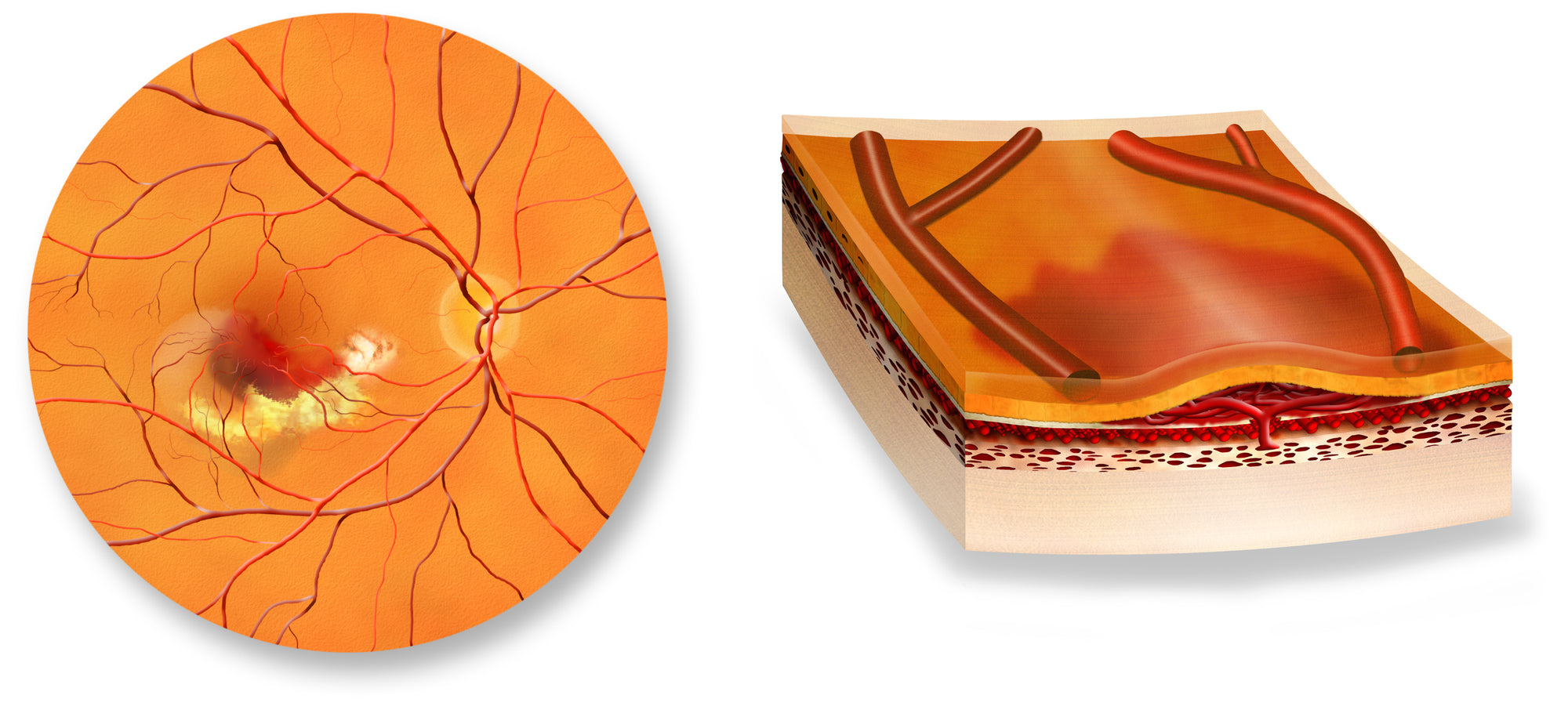In 2009, I sought out a small Canadian company, ArticDx that was doing work in the genetics of macular degeneration. I met their C.E.O., Greg Hines in my medical office. Eleven years later, scientists have now proven that some people would do better to amend their AREDS 2 regimens by eliminating zinc and copper. VisiVite was among the first eye vitamin companies in the world to offer a zinc-free AREDS 2 eye vitamin formula.
Here for posterity, is my 2009 article explaining the genetics of macular degeneration. We were ahead of our time. Medicare is on the cusp of approving a laboratory test and advising patients with macular degeneration how to alter their formula based on the results.
Paul Krawitz, M.D.
Inflammation and Oxidation - the very two processes that are already known to increase the development and progression of age-related macular degeneration - have now been shown to be of much greater risk in people with genetic abnormalities, smoking and increased weight.

|
| Greg Hines and Dr. Paul Krawitz in 2009 |
Stopping smoking and losing weight can be changed. But not so your genes. And until now, people have been in the dark about their real risk for developing macular degeneration.
That's about to change. ArcticDx, a Canadian company, is less than a year away from bringing to market a simple test of saliva that Greg Hines, President and CEO claims, "will uncover 70% of people that are going to get the disease." Greg's hope is that armed with this new knowledge, patients will be able to more aggressively seek early treatment, and furthermore, that future treatments will be more effective in aiming toward this select genetic group.
I interviewed Greg on March 12, 2009, and he helped to clarify for me what has been discovered so far, and how the company plans to use that knowledge in the testing of patients.
Fifty years after the discovery of the structure of DNA by James Watson and Francis Crick, the Human Genome Project was completed. The HGP micro-analyzed the 25,000 genes in human DNA and provided the tools for the private sector to analyze this mountain of data.
Don't Know Genes? Here's a Simple Explanation
Everyone has heard of DNA, chromosomes and genes, but most people don't know the difference. So we're going to make it simple.
 Watson and Crick discovered DNA |
A (deoxyribonucleic acid) is the coiled molecule found in every single cell inside your body. Each DNA molecule (also known as a chromosome) contains thousands of building blocks called 'base pairs' that are linked together like a train. But unlike most trains, DNA is linked with its mirror-image buddy. Scientists refer to this as being "double stranded."
There isn't just one DNA molecule (chromosomes) in each cell, but rather 22 identical pairs of each unique DNA molecule and one pair of gender (X & Y) chromosomes.
Now it turns out that the base pair building blocks in the chromosomes are not entirely random, but rather tend to run in clusters. It's as if there is a sequence of BLUE-GREEN-GREEN-RED cars making up the first class section of every train. And this cluster, known as a gene, is what determines whether your have brown hair or red, whether you are tall or short, and whether you're going to get macular degeneration. Of course, not everyone has the same genes, so scientists refer to variations of each of these genes as 'haplotypes."
Genes not only determine body characteristics; many of them send messages to create important molecules, including proteins, that enable the body to work efficiently and guard against diseases. Unfortunately, some people don't have the best version (haplotype) of every gene.
The First Big Breakthrough
In the spring of 2005, no fewer than four scientific studies (see Science Magazine and Proceedings Of The National Academy of Sciences) simultaneously discovered that a gene that sent a message for the body to make a protein called Complement Factor H (CFH) was highly predictive of the development of drusen and age-related macular degeneration.
The Alternative Complement Pathway is one of the body's primitive defense systems, more primitive than antibodies, that fights against disease. It consists of a cascading series of proteins that deliver activated enzymes, which in turn rupture foreign cells by damaging their protective membranes. Complement Factor H (CFH) helps this system to avoid getting out of control, making sure that the Alternative Complement Pathway fights only against pathogens and does not damage healthy body tissue.
In short, the job of Complement Factor H is to regulate the inflammation. Like a traffic cop with a blindfold, a defective CFH could allow too much imflammation, which in turn causes unintended damage to the retina and surrounding tissues.
Point proven.
Each of the four studies showed that CFH accumulated inside retinal drusen, the hallmark lesion of dry macular degeneration, and that specific variations of the CFH molecule could either confer protectiveness or increased susceptibility to macular degeneration. The researchers all found that the Y402H haplotype, which involves a single amino acid pair change on the gene region for CFH on chromosome 1, was highly associated with an increased risk of age-related macular degeneration. People with this genetic variant are two to four times more likely to get AMD.
Subsequent work by Dr. Anand Swaroop, formerly from my alma mater, the University of Michigan in Ann Arbor, and now with the National Eye Institute, showed that there were at least 80 variants (haplotypes) to the CFH gene, some protective and some harmful. The worst haplotype, worse even than Y402H, increased the risk of developing AMD by nearly 40-fold!
Other Important Information
Similar to the findings with the CFH gene, variations in the HTRA-1 (ARMS2) gene have been shown to increase the odds of developing AMD by as much as eight-fold.Unlike the complement system, these variants appear to increase oxidative stress and the likelihood of developing wet macular degeneration.
There is also a mitochondrial marker gene. The mitochondria is the structure inside our cells that generates chemical energy and performs other important tasks to maintain the health of the cell.
Smoking, an independent risk factor responsible for perhaps 10% of all cases of AMD, poses an even greater risk if the person also has the ARMS2 gene - according to Greg Hines at ArcticDx, the odds increase by 3.5 fold.
What The Macula Risk Test Can and Cannot Do
The Macula Risk cannot tell you with 100% certainty if you are going to get the disease. Rather, by assessing multiple genetic risks and other modifiable risks such as smoking and obesity (Body Mass Index), the test will tell you how your risk compares with the general population. According to Mr. Hines, the average Caucasion has a 9.8% chance of developing AMD in his or her lifetime. And ArcticDx states that Macula Risk will uncover almost 4 out of 5 people destined to get the condition.
I asked Greg whether people would really want to know this information.
"95% of people want to know," he said, "but only if something can be done."
And the early research supports the fact that not only will people potentially receive treatment earlier in their disease, but that some of the treatments are actually more successful in patients carrying the very genetic variation that puts them at risk.
"Presence of the CFH gene variant," Greg said, "is related to the success of injectable Anti-VEGF therapies, such as Lucentis and Avastin."
Our Recommendations
Many in our society are not yet ready for the powerful information that will come from the Macula Risk test. Doctors are rightfully concerned about how patients will handle this information emotionally, despite the efforts being taken to thoroughly counsel those with results of higher risk.
But despite a 2006 editorial in the professional journal, Ophthalmology (Volume 113, pp 509-10) which advised against testing because of unnecessarily frightening some people who might test as higher risk, but never develop the disease, we feel that the testing is much more precise than it was three years ago, and that such thinking is merely burying our heads in the sand.
We predict in the next 5 to 10 years, that people will routinely accept tests such as the Macula Risk to better educate themselves about their risks of developing diseases and conditions. We also predict that future research will focus on these select groups with genetic variations that place them at risk, thus providing greater hope for successful prevention and treatments.
The Pandora's Box of discovering genetic risk for breast cancer, colon cancer, macular degeneration, and more, can no longer be closed. But unlike Pandora, inside the box are not evils but information, information that will serve to guide the speed and accuracy of intervention.
The biggest downside is that the information, once obtained, might fall into the hands of companies that provide medical, disability and life insurance. Armed with this information, the companies might refuse to provide coverage, or might do so only at a higher cost. Thus, similar to the accident-prone driver, the risks would not be spread equally over the entire population.
Paul L. Krawitz, M.D., F.A.A.O
President, Vitamin Science Inc.
March 19, 2009














